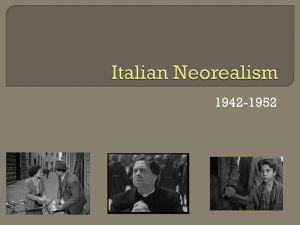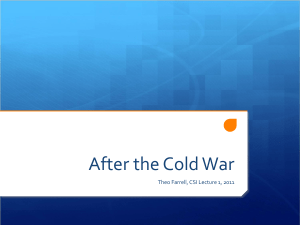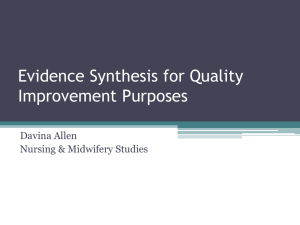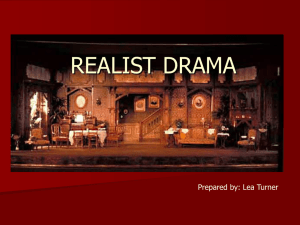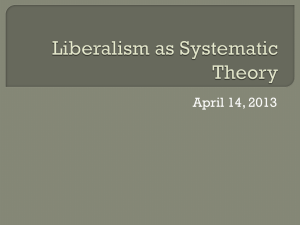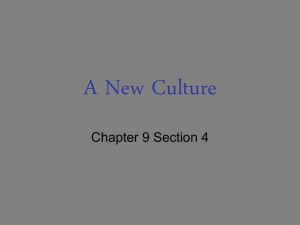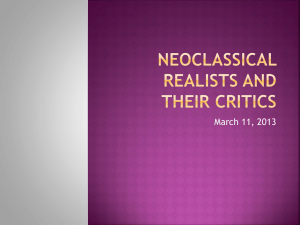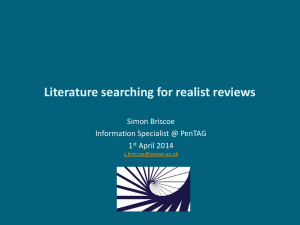International Relations Theory
advertisement
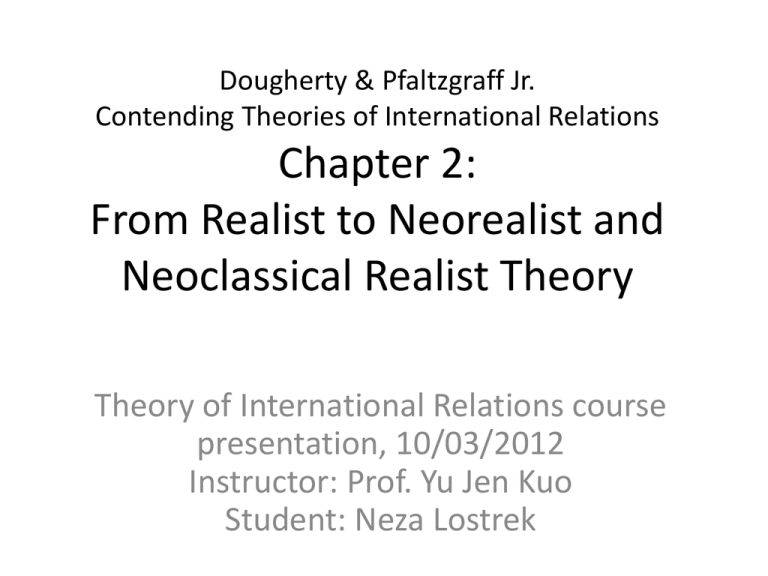
Dougherty & Pfaltzgraff Jr. Contending Theories of International Relations Chapter 2: From Realist to Neorealist and Neoclassical Realist Theory Theory of International Relations course presentation, 10/03/2012 Instructor: Prof. Yu Jen Kuo Student: Neza Lostrek Outline • Theoretical foundations – – – – – The Utopian-Realist Debate The Neorealist-Neoliberal Debate Antecedents of the Realist Theory Power and International Behavior Realist IR Theory. The Mid-Twentieth Century (Hans J. Morgenthau) • Neorealist Theory – Neorealist Theory – Neoclassical Realist Theory – Recent Realist Thought and International institution • Realism, Neorealism, Neoclassical Realist Theory: Limitations and Contributions Theoretical foundations Realist theory held a dominant position in the study of IR in the years between the end of the WW2 into the early 1980 • Classical realist theory – International systems level of analysis and the state, or unit actor level of analysis • Neorealist-structural realist theory – International system level of analysis, addresses the nature of international politics • Neoclassical realist – The state, or the unit, level of analysis Neorealist and Neoclassical realist theory build upon the intellectual tradition of classical realist theory Theoretical foundations • Classical realist theory – key assumptions 1. states as key factors 2. International politics conflictual 3. States exist in a condition of legal sovereignty 4. States are unitary actors (domestic, foreign policy separated) 5. States are rational actors (national interest) 6. Power the most important concept in explaining state behavior • Two essential questions: – What accounts for state behavior in general and in particular for the survival of states? – What produces and accounts for the dynamics of the international system? Theoretical foundations The Utopian-Realist Debate (according to Edward Hallett Carr) • Utopian theory guided the development in IR theory in years between the two World Wars, and especially in the Anglo-American setting • Utopians intellectual descendants of – 18th century Enlightement optimism • Human conduct shaped by environing circumstances – 19th century Liberalism • Harmony of interests at the level of the collectivity – 20th century Wilsonian idealism • International system based on representative governments (from national self-determination to democratic peace theory) Theoretical foundations The Utopian-Realist Debate (according to E. H. Carr) • Realist stressed power and interest rather than ideals in IR and admit that power relationships are often cloaked in moral and legal terms: – Carr notes that the utopian theory of that era merely justified the interests of the dominant Englishspeaking status-quo powers • Sound political theories contain elements of utopianism and realism Theoretical foundations • The Neorealist-Neoliberal Debate • a discord on the extent to which development of institutions can transcend the structural characteristics of the anarchic international system – Robert Keohane: “realists and institutionalists agree that without basis either of hegemonic dominance or common interests, international institutions cannot long survive.” • The neorealist-neoliberal debate has moved away from the sharp delineation to an effort toward synthesis Theoretical foundations Antecedents of Realist Theory • Thucydides (400 b.c.): – “what made (Peloponnesian) war inevitable was the growth of Atenian power and the fear which this caused in Sparta” • Niccolo Machiavelli (1469-1557) – to ensure state’s survival, ruler’s moral standards must be different from those of the individual – is concerned with power – politics as clash of interests – pessimistic view of human nature • Thomas Hobbes (1588-1679) – Without a strong sovereign, chaos and violence follow; there is little prospect for changing human behavior – paradoxically closer to proponents of world government, yet, doubted the possibility of establishing the world empire • Georg Hegel (1770-1831) – State has an “individual totality” that develops according to its own laws – the state’s highest duty lies in its own preservation • Max Weber (1864-1920) – politics characterized by a struggle for power – every big political community a potential aspirant to prestige – every political structure prefers weak rather than strong neighbors – The ethical problem: the absolute ethicsof conviction cannot be separated from an understanding of consequences (ethic of responsibility) Theoretical foundations Power and International Behavior • Power – problem of conceptualization: – Nicholas J. Spykman: power is he ability to move the individual or the human collectivity in some desired fashion, through “persuasion, purchase, barter and coercion” – Arnold Wolfers: power is an ability to move others by the threat or infliction of deprivations, influence is the ability to do so through promises of grants of benefits – Robert Gilpin and Kenneth Waltz: the power of a state consists of capabilities (military, economic, technological, etc.) – Charles P. Kindleberger: strength is a means that exists even in an absence of its use for some goal. power is the use of strength, for a particular purpose; strategy itself becomes a capability Theoretical foundations Power and International Behavior • Power is dynamic and changing, rather than static in nature; entities best able to adjust to change are likely to possess power and to make most effective use of it in support of posited goals. • interdependence connotes the ability of one state to influence another in some way • The level of dependency is determined either by the opportunity costs of foregoing the object at issue or by the extent to which dependent state can substitute another supplier • James A. Caporaso: the nature of dependence includes: – The magnitude of dependent state’s interest in a desire for a good – The extent of the control of the good in question by the party exerting influence – The ability of the dependent state to find an alternative source • Michael P. Sullivan: – major difficulty arises from the need to specify the type of international behavior to be explained by reference to power as the key explanatory variable – we may need an alternative explanation – Large number of national level measurable elements: population, territory, resources, levels of education and skills, GDP, etc.) – Systems level measurements: alliance and non-governmental organization membership and the distribution of capabilities throughout the system as a basis for giving operational meaning to bipolarity and multipolarity Theoretical foundations Realist IR Theory: The Mid-Twentieth Century • Hans J. Morgenthau: – 1. political relations governed by objective rules deeply rooted in human nature; society can only be improved by first understanding these rules and then by basing public policy on that knowledge – 2. political leaders “think and act in terms of interest defined as power” – 3. national interest is defined by national survival – 4. nation-states are governed by a morality that differs from the morality of individuals in their nation personal relationships – 5. moral aspirations of a particular are not identified with the universal moral laws - this enables us to judge other nations as we judge our own – 6. the autonomy of the political sphere; political actions must be judged by political criteria Theoretical foundations Realist IR Theory: The Mid-Twentieth Century • Hans J. Morgenthau: – A political policy seeks either to : 1. 2. 3. preserve status-quo (e.g. Monroe Doctrine, treaties concluded at the end of wars) achieve Imperialistic expansion (could be adopted as a result of victory, defeat, or the weakening of other states, and by military or cultural and economic means) gain prestige (diplomacy and display of force: in order to achieve such a reputation for power that the actual use of power becomes unnecessary) – Conditions for international peace • pursuit of national interests not essential to national survival contributes to international conflict (ideologically motivated foreign policies) • The balance of power (1. a policy aimed at a certain state of affairs / 2. the state of affairs itself, 3. an approximately equal distribution of power/4. any distribution of power); - it is not the balance of power itself but the international consensus on which it is built that preserves international peace • Diplomacy plays crucial role in the preservation of peace Neorealist Theory • Power remains key variable, although less as an end in itself than as a necessary and inevitable component of a political relationship • Neorealist theory draws from classical realism as well as links conceptually other theoretical efforts – Kinderman’s Munich School of Neorealism & constellation analysis – Kenneth Waltz ‘s system constructs – Robert Gilpin’s refinement of classical realist theory – Buzan, Jones and Little’s concept of deep structure Neorealist Theory • Gottfried-Karl Kinderman’s Munich School of Neorealism & constellation analysis • Constellation analysis is an integrated multimethod system of inquiry, • Designed to • explain the behavior of individual actors within an international constellation • analyze multidimensional patterns of interaction within a polycentric setting consisting of two or more monocentric action systems • Posits politics not power as its key concept • Its basic premise is the existence of an international system consisting of interactive elements that are to be studied by reference to concepts derived from classical realist theory, but also based on variables drawn from cross-cultural comparative analysis Neorealist Theory • Gottfried-Karl Kinderman’s Munich School of Neorealism & constellation analysis • Constellation analysis includes six categories for inquiry and analysis: • • • • • • 1. system and decision, including linkages between domestic and foreign policy and decision making 2. perception and reality, including the subjective images of decision makers 3. interest and power, including how decision makers define the role of power in achieving foreign policy goals, based on conceptions of national interest 4. norm and advantage, encompassing how legal, moral or ideological postulates shape the conduct of units of the international system and of systemic structures themselves 5. structures and interdependence (including the effects of structures on levels of interdependence and overall interactive patterns 6. cooperation and conflict, or how all of the aforementioned categories shape the strategies of actors toward other actors and lead to patterns of cooperation, conflict, or neutrality Neorealist Theory Robert Gilpin • Attempts to refine the rationality assumption of the classical realist theory • States engage in cost-benefit calculations • Costs of changing form the principal barriers to disruptive or destabilizing action • Distribution of power principal means for controlling the behavior of the states • Dominant states maintain a network of relationships within the system for this purpose Neorealist Theory Kenneth Waltz & structural realism • Structure connotes the way in which the parts are arranged • Structures are either hierarchically (states) or anarchically (international order) organized • The more hierarchical the system, the greater the differentiation of functions • Structure is defined by the distribution of capabilities among the units ( necessary emergence of a balance of power) • Structure is based on the fact that units differently juxtaposed and combined behave differently and in interacting produce different outcomes • Structure is a variable conditioning political behavior • If structure defines the arrangements of the parts, what accounts for change in the structure? – structures emerge from the coexistence of the primary political units of a given era • structural realism does not address the reductionist question of how and why such political units come into existence at a particular time in history Neorealist Theory Robert Gilpin • In deciding in foreign policies that would produce change in the international system states do not attempt to achieve one goal at the sacrifice of others but instead make trade-offs with various objectives (satisficing approach) • International systems undergo three types of change – Alteration in the types of entities that compose a particular international system (systems change): a system changes as the cost-benefit ratio of membership in the existing system is altered – A change deriving from the components within which change takes place (rise and fall of the powerful states that shape patterns of international interactions – Change in nature of its members’ political, economic and sociocultural interactions • A system in which the cost of expansion equals or exceeds its perceived benefits is in equilibrium • There is a tendency for the economic cost of maintaining the status quo to increase faster than the economic capacity to support it • Historically, war has been the primary means by which the issue of disequilibrium has been resolved Neorealist Theory Critique of Kennet Waltz’s structuralism • Waltz’ neorealist theory sparked a debate that has dominated the IR theoretical landscape since the early 1980s • Waltz has neglected both the role of the units and the impact of the structure of the units themselves on the behavioral patterns of their members • Theory of international politics must include the domestic politics of the units, to the extent that they shape foreign policy Neorealist Theory Barry Buzan, Charles Jones and Richard Little • Rules, regimes and international institutions need to be brought into the definition of international political structure • deep structure – Political structure encompasses anarchy as well as hierarchy – If units are similar, their relationship is based on sovereignty – In international organizations units exist in a hierarchical setting and undertake some government-like functions • Deep structure includes rules and norms (international political system) • The state is not exclusive basis for government (additional sectors which exercise control by coercion are economic, societal as well as strategic) • how states choose to use their capabilities is not the same as how actors are ranked in the system structure • The nature of unit capabilities affects system structure (technology and shared norms and organizations • The systemic dimension of interaction forms a component of a broadened neorealist– structural-realist theory Neoclassical Realist Theory • An effort to bridge domestic and international politics and specifically to relate domestic structures to international structures • States engage in international strategies termed external extraction (accumulation of resources from beyond the state borders) and external validation (use of leaders’ authoritative status within the international community to enhance their domestic status) • Foreign policy is the result of complex patterns of interaction within and between the both levels of competition and cooperation Neoclassical Realist Theory • states may adopt various forms of cooperative or conflict policies, the main question is what explains their propensity to opt for one such strategy or another? • International systems structure is dependent on a host of other factors located within the units themselves (the ways in which states develop and engage their respective capabilities, the strategies they formulate for survival, the mechanisms by which they make decisions, the collective perceptions about the outside world, the estimates about their own relative capabilities, and the historical, cultural, and geographical circumstances upon which they shape their responses to external challenges) • Neoclassical realists, who downplay the international systems level fall within what is termed Innenpolitik Recent realist Thought and International Institutions • Joseph Grieco: for small and mini states voting in international institutions the only way to exert influence on the global scene • Contingent realism (Charles L. Glaser): international institutions play an important role in reducing or minimizing the security dilemma • Institutions reflect the preferences of actors • To the extent that domestic preferences shape the foreign policy of democratic states, we come close to the democratic peace theory • Recent neoclassical realist theory contributes to a synthesis between neorealist/structural realist and neoliberal institutionalist theories Realism, Neorealism, Neoclassical realist Theory: Limitations and Contributions • Limitations: fractured foundation undermines realism’s structural integrity – Self-help in the form of power balancing • History shows that other strategies were more likely to be employed as a response to crucial threats to states’ security – The concept of national interest • Too obvious and unilluminating • It is difficult to give it an operational meaning as it depends on how a specific national identity is constructed – Realism draws from the Eurocentric system of the past and cannot be applied to contemporary global international system – It is normative in terms of prescribing believingly appropriate actions to statesmen – Too much emphasis is placed on power, which subsumes various very different categories of variables , to the relative exclusion of other important variables – Reduces politics to rational interpretations Realism, Neorealism, Neoclassical realist Theory: Limitations and Contributions • Contributions: – Realism ranks as the most important attempt thus far to isolate and focus on a key variable in political behavior and to develop a theory of international relations – Robert O. Keohane: “Realism provides a good starting point for the analysis of cooperation and discord, since its tautological structure and pessimistic assumptions about individual and state behavior serve as barriers against wishful thinking.” – It should be viewed less as a coherent theoretical position than as a site of a great many contested claims (Walker) – As it addresses body of issues, crucially important to international relations, its impact has been pervasive and enduring

